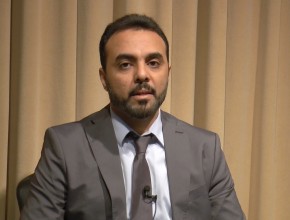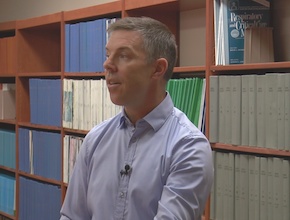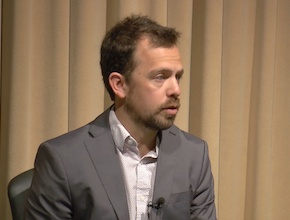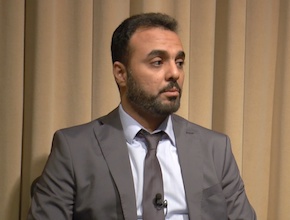References
Rhodes A, Evans LE, Alhazzani W, et al. Surviving Sepsis Campaign: International Guidelines for Management of Sepsis and Septic Shock: 2016. Crit Care Med. 2017 Jan 17. doi: 10.1097/CCM.0000000000002255. [Epub ahead of print] PubMed PMID: 28098591.This video is part of a special 6-episode series of McMaster Perspective focusing on Surviving Sepsis Campaign 2016 guidelines.
Roman Jaeschke: Good morning. Welcome to another edition of McMaster Perspective. Again, our star performer is Professor Waleed Alhazzani. We were talking already about resuscitation and partially about use of antimicrobials. Maybe we will start by continuation on antimicrobials. Duration of therapy – could you expand on this? There was a number of recommendations.
Waleed Alhazzani: When we issued the guideline, we wanted to specify when you should give antibiotics, what dosing is appropriate, and how you consider those, but also we wanted to make sure that there is some guidance with regards to duration of antibiotic therapy. Obviously, we cannot address every single infectious disease, but for the common infections that we see in the intensive care unit (ICU), probably a duration of up to 7 days is appropriate as opposed to longer durations, where we used to treat patients for 2 weeks or sometimes longer, which have been shown not to be superior to giving shorter duration of antibiotics. And we know that giving shorter duration – if it resulted in similar outcomes – probably would also result in fewer side effects and less risk of developing resistance, maybe fewer complications, such as Clostridium difficile, that we worry about in the ICU.
Obviously, there will be some exceptions. If readers are interested, they can refer to specific guidelines and specific infectious diseases, but this is the general guideline or timelines for clinicians to look at. Obviously, patients with, for example, endocarditis might require longer duration [of antibiotic therapy], patients with multidrug-resistant organisms may require longer duration, complicated intra-abdominal sepsis with abscesses that is not well controlled might have a different duration. So we cannot apply or generalize this recommendation to every context, but this is the general threshold.
RJ: The general idea, historically at least, is to keep shortening the duration of antibiotics, providing that there is an adequate source control.
WA: Of course.
RJ: Talking about shortening antibiotics, could you tell us a few words about procalcitonin use?
WA: Another excellent question, Doctor Jaeschke. To decide whether to shorten the antibiotic or stop treatment, you would have some threshold in mind. You could also do that clinically by assessing the patient’s response to treatment and hemodynamics, but you could also use biochemical markers.
In this iteration of Surviving Sepsis [Campaign], we issued a weak recommendation on using procalcitonin for de-escalation or even for stopping antibiotic use. This is – mind you – based on low-quality evidence, and it is still a weak recommendation; it is a suggestion, for example, for centers that have the facilities to perform procalcitonin [testing, where] it is an option to be used. However, I will not say that this should change practice, I will not say that every center should be starting measuring procalcitonin levels in every patient. We do not know of the impact of using this intervention. Still, it is based on low-quality evidence, so we are not sure about the utility. That is the first thing.
The second thing is that in the studies that we looked at, there is more than 1 protocol used. So again, we do not know which protocol we should be recommending for people. It is just to highlight that it is maybe a useful test. People could use it if they want to, but if clinicians did not use it... – like in our center, where we do not use procalcitonin and I still feel comfortable managing patients even after looking at the data. I still feel comfortable de-escalating therapy and stopping therapy without the use of procalcitonin.
RJ: That is useful. Thank you. Talking about some controversial topics – let’s move to fluid therapy. What would be your understanding of this discussion, which historically generated most emotions?
WA: After going through the methodology of looking at fluid trials and resuscitation in sepsis, I realized how little we know, honestly, about this common intervention that we use on daily basis. I am talking about intravenous (IV) fluids in general, because there are different types and subtypes of fluids. If you asked me which fluid we should be using all the time, I would not be able to answer that question with a high degree of certainty. However, the controversial areas we discussed were the amount of initial fluid bolus but also what fluid to use. The historical classification of fluids as colloids and crystalloids probably does not stand nowadays. It is a pretty simple classification of fluids and probably there are more differences that need to be highlighted when you look at which intervention to use. I am talking about fluids here.
Our guideline recommends using crystalloids as the first initial resuscitation fluid. And that makes sense. For the patient who is hypovolemic, crystalloid is probably more available and probably cheaper, the incremental benefit of using albumin as acute resuscitation fluid is not clear, so it makes sense to use crystalloids if available. Which crystalloid to use for acute resuscitation of sepsis – this is a less clear area. There have been few randomized controlled trials (RCTs) that looked at this question; actually, more of an indirect evidence comparing indirect interventions – call it low or even very low quality.
RJ: Indirect meaning most data are coming from comparison of crystalloids versus colloids, rather than two crystalloids against each other?
WA: Exactly. We do not have high-quality data to answer this specific question. After looking at the indirect evidence and after looking at RCTs in other populations, we felt that probably using either balanced crystalloids or normal saline is still acceptable in patients with sepsis; it is with highlight of monitoring chloride levels if you use normal saline. But we did not feel comfortable at this stage to recommend one intervention over the other. There are trials ongoing and this is probably going to be highlighted as a priority area of research. We are hoping that in the next iteration of the guideline this question will be to some degree answered, or at least we will have some insight about the differential benefit and harm of these 2 interventions.
RJ: Mind you, probably after giving 2 L of normal saline we already start to see hyperchloremia developing fairly quickly, which would direct us towards a balanced solution. Hydroxyethyl starches were out and are out?
WA: Yes, we still make a strong recommendation not to use starches for acute resuscitation in patients with sepsis.
RJ: I have seen that there is a suggestion to use crystalloids rather than another colloid – gelatin.
WA: Gelatin as well was one of the interventions that was not studied extensively in the population of sepsis. Most of the data are either indirect or based on a single small RCT. The group did not feel comfortable saying that we should not be using gelatin, but they felt comfortable looking at the balance between benefits and harms to say that crystalloids are probably well-studied, we use them more often, and we should be using them more often than gelatins. But there will be some centers in different parts of the world that might consider using gelatin. In Canada, where I practice, we do not use gelatin.
RJ: Where does it leave albumin?
WA: Albumin is still part of the recommendations. Again, it was probably the most contentious recommendation that we discussed in this guideline. This again highlights the fact that although these are common interventions that we use on daily basis, we still are not able to answer these questions with a high degree of certainty and future studies are needed. The way it stands now, although that recommendation may sound vague to some people or clinicians, is to use albumin when a substantial amount of crystalloids was used. People ask, “What do you mean by substantial amount of crystalloids?” I think this was left vague and it caused some problems with panel members who wanted to be more specific. We could not be more specific. We intentionally said: the way it is phrased now, when you give patients too much crystalloids you may consider giving albumin as a supplemental fluid...
RJ: The question is how much is too much. I guess your original recommendation is 2 L or 30 cm3 of crystalloids in the resuscitation phase. That would be the minimum considered before you even start thinking about albumin.
WA: Yes. For the acute phase, we said to give crystalloids all the time. We are talking about the subsequent phase, with ongoing resuscitation of patients, ongoing fluid administration. We thought that giving albumin as a supplemental fluid strategy might be a good idea. I understand the issue with the substantial amount of fluid, and I cannot answer this question with a high degree of certainty. Again, it has to be left to the clinician’s judgement when they see the patient and decide about the clinical context. The worry of third spacing with giving too much crystalloids is still a concern.
RJ: I am always glad when there is some flexibility left to clinicians. Why don’t we stop here and return to Surviving Sepsis Campaign in the next section. Thank you.
WA: Thank you.
 English
English
 Español
Español
 українська
українська








